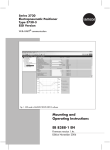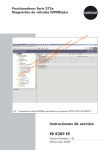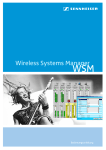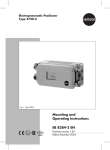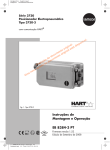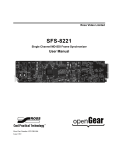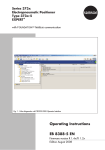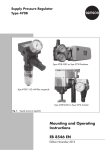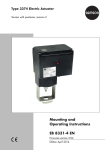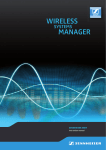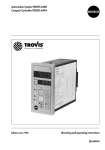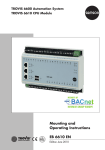Download Operating Instructions EB 8388 EN
Transcript
Series 373x Positioners + EXPERT Valve Diagnostics Fig. 1 · Valve diagnostics with SAMSON TROVIS-VIEW Operator Interface, e.g. for Type 3730-3 Positioner Operating Instructions EB 8388 EN Firmware version 1.4x Edition November 2006 Contents Contents Page 1 1.1 1.2 1.3 1.4 1.5 1.6 1.7 1.7.1 Description. . . . . . . . . . . . . . . . . . . . . . . . General . . . . . . . . . . . . . . . . . . . . . . . . . Diagnostic tests . . . . . . . . . . . . . . . . . . . . . . Activating EXPERT+ . . . . . . . . . . . . . . . . . . . . Actuator and valve specification data . . . . . . . . . . . Start the reference test . . . . . . . . . . . . . . . . . . SUb initialization mode, double-acting actuator and booster Activation, analysis and presentation of diagnostic data . . Printing the diagnostic/ESD log . . . . . . . . . . . . . . 2 2.1 2.2 2.3 2.4 2.5 2.5.1 2.5.2 2.6 Statistical information AUTO . . . . . . . . . . . . . . . . . . . . . . 9 Data logger . . . . . . . . . . . . . . . . . . . . . . . . . . . . . . 9 Travel histogram . . . . . . . . . . . . . . . . . . . . . . . . . . . 11 Setpoint deviation histogram. . . . . . . . . . . . . . . . . . . . . . 12 Cycle counter histogram . . . . . . . . . . . . . . . . . . . . . . . . 13 Drive signal diagram . . . . . . . . . . . . . . . . . . . . . . . . . 15 Steady-state drive signal. . . . . . . . . . . . . . . . . . . . . . . . 15 Hysteresis test (d5) . . . . . . . . . . . . . . . . . . . . . . . . . . 17 End position trend. . . . . . . . . . . . . . . . . . . . . . . . . . . 19 3 3.1 3.2 3.3 3.4 Tests MAN . . . . . . . . . . . . . . Drive signal diagram steady-state (d1) . Drive signal diagram hysteresis (d2) . . Static characteristic (d3) . . . . . . . . Step response (d4) . . . . . . . . . . . . . . . . . . . . . . . . . . . . . . . . . . . . . . . . . . . . . . . . . . . . . . . . . . . . . . . . . . . . . . . . . . . . . . . . . . . . . . . . . . 21 22 23 25 26 4 4.1 4.2 4.3 4.4 4.5 4.6 Status and diagnostic alarms . . . . Standard EXPERT diagnostic alarms . Extended EXPERT+ diagnostic alarms . Logging. . . . . . . . . . . . . . . Classification of the status alarms . . Condensed state . . . . . . . . . . Status modification . . . . . . . . . . . . . . . . . . . . . . . . . . . . . . . . . . . . . . . . . . . . . . . . . . . . . . . . . . . . . . . . . . . . . . . . . . . . . . . . . . . . . . . . . . . . . . . . . . . . . . . . . . . . . . . . . . . . . . . . . 28 28 28 29 29 29 30 5 Resetting diagnostic parameters. . . . . . . . . . . . . . . . . . . . 31 6 Diagnostic parameters saved in non-volatile memory . . . . . . . . . 34 7 Troubleshooting . . . . . . . . . . . . . . . . . . . . . . . . . . . 35 8 EXPERT without TROVIS-VIEW . . . . . . . . . . . . . . . . . . . . 38 2 + EB 8388 EN . . . . . . . . . . . . . . . . . . . . . . . . . . . . . . . . . . . . . . . . . . . . . . . . . . . . . . . . . . . . . . . . . . . . . . 3 3 4 4 5 5 6 7 8 Description 1 Description 1.1 General These instructions EB 8388 EN supplement the standard mounting and operating instructions of the positioners: Type Standard EB 3730-2 EB 8384-2 EN 3730-3 EB 8384-3 EN 3730-4 EB 8384-4 EN 3730-5 EB 8384-5 EN 3731-3 EB 8387-3 EN EXPERT+ is an optional diagnostic firmware integrated in the positioner which allows the predictive, status-oriented maintenance of pneumatic control valves. Refer to section 1.3 on how to activate this option. EXPERT+ upgrades the standard EXPERT diagnostics firmware incorporated in the positioner. The upgraded version provides extended functions to pinpoint valve parameters that have worsened, allowing the user to plan predictive maintenance and service work before malfunctions can affect the process, causing unscheduled plant shutdowns. EXPERT+ records the valve faults in automatic mode while the process is running and issues alarms on the required maintenance work. In addition, numerous tests can be performed in manual mode to pinpoint emerging faults. Owing to the numerous diagnostic tests, EXPERT+ is able to generate classified status alarms on the state of the control valve. The EXPERT+ diagnostics are completely integrated in the positioner. Data required for diagnostics are compiled automatically and the test data are analyzed in automatic or manual mode in the positioner itself. The resulting data are used to issue classified status alarms. The diagnostics data, results and status alarms are available over the DD (Device Description). All the necessary reference graphs are automatically plotted after the positioner has been initialized and are available when required. After performing the basic settings at the positioner using the rotary pushbutton, the TROVIS-VIEW3 or DTM software allow the parameters to be viewed and set conveniently. Type Integration 3730-2 TROVIS-VIEW3 373x-3 TROVIS-VIEW3, DD, DTM 3730-4 TROVIS-VIEW3, DD, DTM 3730-5 TROVIS-VIEW3, DD The following sections contain a description on how to operate the diagnostics over the TROVIS-VIEW3 software. Note! All the parameter settings that are changed over the operator interface must also be downloaded onto the positioner to allow them to become effective. EB 8388 EN 3 Description Note! The optional integrated solenoid valve is implemented by a forced venting function in Types 3731-x Positioners. 1.2 The required activation code can be ordered (order number 1400-9318). On ordering this option, specify the serial number of the positioner (see nameplate or in the software). To activate EXPERT+, proceed as follows: Diagnostic tests Enable configuration at the positioner: There are two main groups of diagnostic tests available. Statistical information AUTO These tests are performed while the process is running (automatic mode) without disrupting the process. Activated tests are automatically performed when they are triggered by their start condition (e.g. data logger and drive signal diagram hysteresis). Other tests are already performed in the background without being activated (e.g. histograms, cycle counter, drive signal steady-state and end position trending). Turn → Code 3, press turn → ON, press , . After enabling configuration: Turn → Code 48, press Code 48 blinks. Tests MAN These tests should not be performed while the process is running (i.e. in manual mode instead) as the positioner cannot follow the reference variable at the same time. The valve is moved to a certain position defined by the test settings and the valve may move through its full range. 1.3 Activating EXPERT EB 8388 EN to select d, press turn to select d8, press , . d8 blinks + The extended EXPERT+ diagnostics can be activated later at the positioner when EXPERT+ is not already activated on delivery of the positioner. 4 Turn Turn and set the activation code XXXX. Press to confirm the entered code. Description These parameters do not need to be changed if the control valve also has these default settings. 1.5 After the activation has been successfully completed, YES appears on the display. Note! On entering the wrong activation code, the display returns to Code 0. The activation of EXPERT+ has been unsuccessful. After an incorrect activation code has been entered three times, Err appears on the display after selecting Code 48 and d8. An activation code can only be entered again after the positioner has been reset to its default settings (Code 36). 1.4 Actuator and valve specification data To correctly analyze the diagnostic data, several actuator and valve specifications need to be entered for the EXPERT+ diagnostics. Enter the required data in the Identification folder (> Positioner > Actuator) as well as (> Positioner > Valve). Download the data to the positioner. The Model and Booster parameters in the Actuator folder and Stuffing box parameter in the Valve folder need to be entered. The default settings of these parameters are: 4 Model > Single-acting 4 Booster > Not present 4 Stuffing box > Self-adjustable Start the reference test After EXPERT+ has been activated properly, the reference graphs for future diagnostic purposes need to be plotted to allow the diagnostics to function in their full scope. The reference graphs are plotted automatically after the positioner has been initialized when the EXPERT+ has been activated (e.g. already on delivery). On activating EXPERT+ at later time, the reference graphs are plotted after the positioner is re-initialized. If reference graph plotting is to be started separately in an initialized positioner or if graphs are to be replotted, proceed as follows: Set the positioner to manual mode: Turn → Code 0, press Code 0 blinks. Turn → MAN, press moves to manual mode. , , the positioner Manual operating mode You can activate the reference test either by selecting the Diagnosis folder (> Start refer- EB 8388 EN 5 Description ence test) and right-click the parameter to select Execute, or, alternatively, start the reference test at the positioner itself by selecting Code 48 as follows: Enable configuration at the positioner: Turn → Code 3, turn → ON, press . After enabling configuration: → Code 48, press Turn Code 48 blinks. nostic reference test. During the reference test, tESt and d1 or d2 appear in alternating sequence on the positioner display. The measured data are used as reference data and any existing reference graphs are overwritten. If the reference graphs could not be plotted correctly or are incomplete, Code 81 is issued and saved in a non-volatile memory. The positioner can function properly after it has been initialized successfully without the reference data. 1.6 until d appears, press Turn to select d7, press turn , . d7 blinks. SUb initialization mode, double-acting actuator and booster The following points need to be observed when the positioner is initialized in SUb mode or when a double-acting actuator and/or booster is used: Positioner initialization in SUb mode: 4 Analysis in automatic or manual mode is deactivated. 4 All tests for both statistical information → ON, Turn press to start the reference test. Caution! The control valve moves through its travel range during the reference test. The tests d1 (drive signal diagram steady-state) and d2 (drive signal diagram hysteresis) are performed during the diag- 6 EB 8388 EN 4 4 AUTO and tests MAN of drive signal diagrams steady-state and hysteresis are inactive. The reference test is inactive. The automatic test to start all tests MAN is inactive. Double-acting actuator with reversing amplifier: 4 All tests for both statistical information 4 AUTO and tests MAN of drive signal diagrams steady-state and hysteresis are inactive. The reference test is inactive. Description Booster: 4 The analysis of the tests for both statisti- cal information AUTO and tests MAN of drive signal diagrams is inactive. 1.7 Activation, analysis and presentation of diagnostic data All diagnostic tests which do not compile data automatically in the background (data logger, drive signal diagram hysteresis) must be activated to start them. To start these tests, select the corresponding test order (> Start data logger or Start test) and right-click the parameter to select Execute to activate the test. Note! The tests in statistical information AUTO in automatic mode can only be activated when the positioner is in automatic operating mode. To activate the tests MAN in manual mode, the positioner must first be set to manual mode over Code 0. 4 Press once to cancel the tests MAN d1 (drive signal diagram steady-state) d2 (drive signal diagram hysteresis) d3 (static characteristic) d4 (step response), and the test in statistical information AUTO d5 (drive signal diagram hysteresis) as well as the reference test over Code 48. On canceling a test (d1 to d4), the positioner moves to the fail-safe position. The positioner only goes into automatic mode on canceling test d5. The reference graphs must be plotted before the tests for drive signal diagrams steady-state and hysteresis in manual mode can be analyzed. Note! The analysis of raw data in automatic mode is started after the positioner has been in controlled operation for over one hour (after initialization). This does not apply to the end position trend test and the dynamic stress factor in the cycle counter histogram as their analysis starts directly after controlled operation begins. Canceling diagnostic tests There are two ways to cancel an active test: 4 On the TROVIS-VIEW operator interface, select the corresponding folder (> Stop test) to cancel the test. The positioner then moves to the previously set operating mode and to the travel value previously set (manual mode) or returns to the reference variable (automatic mode). Alarms generated from the tests MAN are marked TEST. If the electrical auxiliary power is too low, the test being performed is ended and the positioner moves to the fail-safe position. Upon failure of the auxiliary power, tests in tests MAN and statistical information AUTO must be restarted due reasons of safety. EB 8388 EN 7 Description However, the test in statistical information AUTO drive signal diagram hysteresis remains activated. In the event that the solenoid valve (Type 3730-x) is triggered or the forced venting function (Type 3731-x) is activated, active tests are stopped and the positioner moves to the fail-safe position. However, the test in statistical information AUTO drive signal diagram hysteresis remains activated. In the event that the solenoid valve (Type 3730-x) is triggered or the forced venting function (Type 3731-x) is activated, active tests are stopped and the positioner moves to the fail-safe position. 1.7.1 Printing the diagnostic/ESD log The Print command allows you to print out a diagnostic log of individual tests or the entire diagnosis. The diagnostic log includes a title page and a list of all the data points including all their values and properties. The title page contains all key information for clear identification of the printed log (device type, file name, time and date of creation, time and date of the last change and TROVIS-VIEW version). Select Print in the File menu to add further information. 1. In the File menu, select Print Options to choose the scope of the diagnostic log. After installing/updating the TROVIS-VIEW software, customer data (Customer data in the Edit menu) and 8 EB 8388 EN summary (table of contents) are listed in the diagnostic log by default. Check the check boxes for the Comments and Graphics options to add these options to the diagnostic log. 2. Right-click the [Diagnosis] folder or the required subfolder and select Print from the context-sensitive menu to print the diagnostic log. The printout contains the contents of the folder and its subfolders. Statistical information AUTO 2 Statistical information AUTO The signals x, w and y need to be analyzed on a more precise basis to obtain advanced diagnostic information also over the valve, actuator and pneumatic air supply. The positioner compiles raw data for this purpose. The signals are plotted, stored and analyzed while the process is running. In addition, an additional underlayed hysteresis test detects any changes in friction. The diagnostic tests do not have any affect on the positioner’s control performance. 2.1 Data logger The data logger allows the reference variable w, controlled variable x in relation to the working range, drive signal y and setpoint deviation e to be plotted over time. The measured data are saved in an FIFO memory with a capacity to save 100 data points in the positioner. In addition to the permanent plotting of data, the plotting can be automatically triggered when a start condition is fulfilled. The travel condition (setpoint) or the optional integrated solenoid valve (optional integrated forced venting) can be used to trigger the data logger. The data logger is completely integrated into the positioner. The software is only necessary for activation and to set the parameters. In addition, the measured data can be viewed as a graph or in a list by selecting Upload from Device in the Device menu or by clicking on the device toolbar. Note! Upon disconnection of the auxiliary power or upon changing the operating mode, the test is inactive and must be reactivated. Data logging Select Data logger folder (> Selection) and select Permanent or Trigger and set the Scan rate parameter. Right-click the Start data Fig. 2 · Statistical information AUTO EB 8388 EN 9 Statistical information AUTO logger parameter and select Execute to start data logging. Permanent data logging The variables w, x, y, and e are logged according to the adjusted scan rate and saved in the FIFO memory which always stores the last 100 measured data points of each variable. Triggered data logging On selecting Trigger in the Selection parameter, the data logger records the measured data permanently in the background. A triggering event leads to the last 100 measured data points being stored together with the pretrigger time and leads to the data logging of the triggering condition. The following parameters can be changed for this function: Fig. 3 · Data logger 10 EB 8388 EN 4 Trigger status: 4 4 Triggered by the travel condition (setpoint) and/or solenoid valve condition (forced venting) Start value: Limit indicating from which travel condition (setpoint) the data logger should be triggered Logging limit: Indicating whether data logging should start when the travel condition (setpoint) exceeds or falls below the start value. Travel condition (setpoint) Note! The valve position is used as the travel condition in positioners in ESD version. Select Trigger status parameter and select Start trigger via travel condition (setpoint). Activate data logging by selecting Start data Statistical information AUTO logger parameter and select Execute. The triggering event starts data logging when the start value exceeds or falls below an entered value. Enter the required value at which data logging should be triggered in relation to the setpoint in the Start value parameter. Select whether data logging should start when the entered value exceeds or falls below the start value in the Logging limit parameter. After being triggered, the variables w, x, y and e are logged at the adjusted scan rate and saved in the FIFO memory. Additionally, there is a pretrigger time available to allow the variables to be stored that were logged before the triggered event. Enter the required pretrigger time by right-clicking the parameter and selecting Modify. However, the pretrigger time entered may not be higher than the maximum pretrigger time determined by the positioner. This maximum pretrigger time is shown in the Max. pretrigger time parameter. The data logging finishes automatically as soon as the maximum memory capacity of 100 measured data points for each variable including the pretrigger time is reached. Solenoid valve condition (forced venting) Select Trigger status parameter and select Start via solenoid valve condition (forced venting). Activate data logging by selecting Start data logger parameter and select Execute to start data logging as soon as the integrated solenoid valve is triggered or the forced venting function is activated. Similar to the travel condition (setpoint), the variables w, x, e and y are logged at the adjusted scan rate and saved in the FIFO memory on triggering. Additionally, there is a pretrigger time available to allow the variables to be stored that were logged before the triggered event. Enter the required pretrigger time by right-clicking the parameter and selecting Modify. However, the pretrigger time entered may not be higher than the maximum pretrigger time determined by the positioner. The data logging finishes automatically as soon as the maximum memory capacity of 100 measured data points for each variable including the pretrigger time is reached. Travel (setpoint) or solenoid valve condition (forced venting) Select Trigger status parameter and select Start via travel (setpoint)/solenoid valve condition (forced venting). Activate data logging by selecting Start data logger parameter and select Execute. The triggering event starts data logging when the valve travel (setpoint)/solenoid valve conditions (forced venting) are met. The measured data are plotted over time in graphs. In addition, the compiled measured data are stored in the Measured values folder (see Fig. 3). 2.2 Travel histogram The valve travel histogram is a statistical analysis of the plotted valve travel. The histogram provides information, for example, about where the valve mainly works during its service life and whether it shows a recent trend concerning changes in its working range. The valve travel is recorded and assigned to valve travel classes. The distribution showing EB 8388 EN 11 Statistical information AUTO how often the valve travel remains within a class is shown in per cent. The result is presented as a bar graph. The Travel histogram folder contains long-term data, i.e. measured data are updated cyclically (scan rate 1 s) over the entire positioner service life and stored every 24 hours in the positioner’s non-volatile memory for long-term monitoring. The Number of measurement values parameter shows the total amount of classified measured data points previously recorded. The Average value x long parameter contains the class in which the travel remained on average the most. In order to be able to recognize any short-term changes in valve travel properly, the last 100 measured data points are stored at a scan rate (default: 1 s) in a non-volatile memory. The scan rate can be changed in the Scan rate short time param- Fig. 4 · Travel histogram 12 EB 8388 EN eter. On changing the scan rate, old data in the short-term histogram are deleted. The Average values x short parameter contains the average class assignment for the last 100 measured data points stored in the non-volatile memory. Data can be reset in the Status messages folder. 2.3 Setpoint deviation histogram The setpoint deviation histogram contains a statistical analysis of any setpoint deviations recorded. This provides a summary of how often and to which level a setpoint deviation has occurred during the positioner service life and whether it shows a recent trend concerning the setpoint deviation. The setpoint deviation is recorded and assigned to predetermined level classes. The percentages showing how often the setpoint deviation remains within a class is presented Statistical information AUTO as a bar graph. Ideally, the setpoint deviation should be as small as possible. Similar to the valve travel histogram, the Setpoint deviation histogram folder contains long-term data, i.e. measured data are updated cyclically (scan rate 1 s) over the entire positioner service life and stored every 24 hours in the positioner’s non-volatile memory for long-term monitoring. Additional information determined from this long-term histogram are shown in Fig. 5. The minimum and maximum setpoint deviations are also indicated. In order to obtain a summary of recent setpoint deviations, the last 100 setpoint deviations are logged at an adjustable scan rate (default: 1 s) and saved in an FIFO memory. The scan rate can be changed in the Scan rate short time parameter. On changing the scan rate, old data in the short-term histogram are deleted. The Average values e short parameter indicates the class in which the last 100 measured setpoint deviations were stored on average in the FIFO memory. Data can be reset in the Status messages folder. 2.4 Cycle counter histogram The histogram shows the span of cycles the valve has moved through and the frequency of the cycles. A valve cycle starts at the point where the valve stroke changes direction until the point where it changes direction again. The valve stroke between these two changes in direction is the cycle span. The cycle counter histogram provides a statistical analysis of the cycles. As a result, the cycle counter also provides information on the dynamic stress of a bellows seal or packing. Fig. 5 · Setpoint deviation histogram EB 8388 EN 13 Statistical information AUTO The Dynamic stress factor parameter is specified as a percentage reflecting the stress of the packing. An alarm is issued if the dynamic stress factor exceeds 90 %. The Dynamic stress factor is determined from the cycle span and how often the cycle spans occurred (frequency) depending on which packing has been selected (see section 1.4) self-adjusting, adjustable or bellows seal. To ensure this factor is correctly determined, make sure the correct packing is selected in the Stuffing box parameter in the Identification folder (> Positioner > Valve). The cycle counter records the number of cycles and the cycle spans which are assigned to cycle classes. The calculated percentages on how often a cycle occurs within a class are shown as a bar graph. The Cycle counter histogram folder contains long-term data, i.e. measured data points are updated cyclically over the entire Fig. 6 · Cycle counter histogram 14 EB 8388 EN positioner service life and stored every 24 hours in the positioner’s non-volatile memory for long-term monitoring. The Average value z long parameter contains the cycle class in which the average cycle spans were found. The Counter of all measured values parameter contains the total of classified measured data points previously recorded. In order to obtain a summary of recent cycles, the last 100 cycles measured are stored in an FIFO memory. The Short folder contains this additional cycle counter histogram. The Average value z short parameter contains the average cycle class for the last 100 measured data points stored in the FIFO memory. Data can be reset in the Status messages folder. Statistical information AUTO 2.5 Drive signal diagram 2.5.1 Steady-state drive signal The signature diagram plotting drive signal versus valve position is based upon the drive signal y being the internal control signal of the i/p converter. This signal runs linear in relation to the valve position, similar to the signal pressure in the pneumatic actuator. This graph is plotted after initialization and is stored as a reference in the positioner. A pressure drop across the valve while the process is running causes the signal pressure in the actuator to change by the same amount as the valve travel because the flow forces have an affect on the equilibrium of forces at the valve stem. A similar effect arises when the actuator springs loose their compression due to one or more springs failing. As a result, a change in the correlation between the internal drive signal y and the valve travel also pinpoints to one of these events having occurred. A reduced spring force or a control valve with the fail-safe position ”Fail-to-close” leads to the drive signal y shifting downwards with an ever smaller gradient. In contrast, the pressure drop across the valve while the process is running does cause the drive signal y to drop, but the gradient rises irrelevant of the valve travel. If significant leakage in the pneumatics arises due to screw fittings that are not tightened properly or due to a tear in the diaphragm, the drive signal even starts to rise steadily at a certain valve opening compared to the reference graph. The drive signal y starts to rise almost unsteadily at the restricted valve position if the positioner supply pressure is insufficient. The steady-state drive signal diagram contains recent data to allow recent changes to be recognized. Furthermore, long-term data are also analyzed to be able to detect problems due to supply pressure changes or air Fig. 7 · Steady-state drive signal diagram EB 8388 EN 15 Statistical information AUTO leaks in the pneumatics before they have an impact on the process. The measured data allows the following problems to be detected and the associated alarms to be issued: 4 Air leakage in the pneumatics 4 Spring force reduced 4 Changes in supply pressure The valve position and its associated drive signal y are measured after the pressure conditions have settled (steady-state). Each pair of measured data points recorded is assigned to a valve position class. The average drive signal y is calculated for each class. The stored data can be read. The reference data required are plotted and stored after initialization. Long-term monitoring The long-term monitoring involves the average drive signal y for each valve position class being determined from all measured data points per valve position class. The Long-term folder contains a table of the valve position classes with the associated average drive signal y. Short-term monitoring The short-term monitoring involves the average drive signal y determined from the last measured data points per valve position class. This allows short-term changes in actuator pressure to be pinpointed at various valve positions. The Differential drive signal and Valve positions folders contain a table of the last ten measured data points. 16 EB 8388 EN Graphs The Steady-state folder contains a common graph for long-term, short-term and reference data. The graph plotted using the reference data covers the full range of the valve. The data for long-term and short-term monitoring are recorded online while the process is running, and therefore, the graphs do not necessarily cover the full range of the valve. Reference values are used in cases where no data could be compiled for valve positions x as the valve did not move to those positions or a steady-state could not be reached. The diagram allows changes in drive signal y at the corresponding valve positions to be easily recognized. Changes in pressure are also evident as the drive signal y is proportional to the actuator pressure. Data can be reset in the Status messages folder. Test requirements: A successfully plotted reference graph is necessary to record and analyze the data. Refer to section 1.6 in case a double-acting actuator with reversing amplifier or a booster is used or SUb initialization mode is set. Note! The valve can be moved through its travel range in manual mode, during plant shutdown or when the process allows it by selecting Drive signal diagram steady in Test MAN to check the results or statements determined in automatic mode in the Status message folder (> Extended). Statistical information AUTO 2.5.2 Hysteresis test (d5) The hysteresis test allows changes in friction to be analyzed and an alarm is issued when a significant change in friction is detected. If the diagnostic test d5 is activated and the condition for the Minimum time between tests parameter is met and the pressure conditions have settled, the test is performed with a change in travel < 1% to find ∆y. tESt and d5 appear on the positioner display in alternating sequence and for manual mode appears while the test is running. The test is immediately canceled and the positioner returns to automatic mode if the valve travel leaves the tolerance band or a change in the reference variable occurs which is greater than the tolerance band set. If the test was interrupted due to a change in the reference variable, the test is started again after waiting 30 seconds using the new operating point. If the test is canceled again at this point due to a change in the reference variable ∆w, the test is started again after waiting 60 seconds with the operating point. This can happen ten times, during which the time between tests is increased by 30 seconds each time (30 s x Number of tests repeated). After the test is canceled for the tenth time (due to ∆w), the time entered in Minimum time between tests parameter is kept again. The hysteresis test is deactivated by default. We recommend activating the test after entering Minimum time between tests by selecting Start now. The Minimum time between tests and the control parameters are stored in the non-volatile memory of the positioner. Fig. 8 · Hysteresis test diagram EB 8388 EN 17 Statistical information AUTO Long-term monitoring The measured results ∆y are classified according to the valve position x in the valve position classes. The average value ∆y per valve position class is determined from all the measured data. The Long-term folder contains a table of the results. Short-term monitoring To provide a short-term trend, the last ten valve positions x and the associated ∆y values are saved in the Short-term folder (> Valve position and Difference signal drive). Graphs The Hysteresis folder contains a graph with two curves plotted. The Measurement curve shows the measured data recorded for long-term monitoring and the Reference curve shows the reference data recorded after initialization. The graph plotted using the reference data covers the full range of the valve. The data for long-term monitoring are recorded online while the process is running, and therefore, the graphs do not necessarily cover the full range of the valve. Reference values are used in cases where no data could be compiled for valve classes. If the test has not yet been activated, the graph for the reference data is represented by a straight line. The diagram allows changes in ∆y with the corresponding valve positions to be recognized. Changes in friction are highlighted as ∆y is proportional to the actuator pressure which, in turn, is a measurement for friction. A 18 EB 8388 EN change in friction leads to an alarm being issued. Test requirements: The test is possible in relation to the travel range between 2 and 98 %. 4 A successfully plotted reference graph is 4 4 4 necessary in order to analyze the friction. The test can only be started when the tolerance band (Code 19) or Positioner folder (> Error control > Tolerance band) is greater than 1 %. The characteristic type (Code 20) must be set to Linear in order to record the data. Refer to section 1.6 in case a double-acting actuator with reversing amplifier or a booster is used or the SUb initialization mode is set. Note! The valve can be moved through its travel range in manual mode, during plant shutdown or when the process allows it by selecting Drive signal diagram hysteresis in Test MAN to check the results or statements determined in automatic mode in the Status message folder (> Extended). Statistical information AUTO The following parameters are changed during hysteresis test/d5 correspondingly: 4 Lower x-range value (Code 8): 0 % 4 Upper x-range value (Code 9): 100 % 4 Lower/upper x-limit (Code 10/11): OFF 4 Setpoint cutoff w decrease/increase (Code 14/15): OFF 4 Pressure limit (Code 16): Active pressure limit is raised one stage higher 4 W-ramp OPEN/CLOSED (Code 21/22): Variable Data can be reset in the Status messages folder. 2.6 End position trend The end position trend is used to detect a creeping zero point shift due to seat and plug wear or dirt between the seat and plug. A fluctuating zero point also causes an alarm to be issued. To accomplish this function, the valve posi- tion x and the drive signal y are automatically logged and time-stamped by the operating hours counter in automatic mode when the valve moves to the lower end position. The measured data are stored in an FIFO memory that always stores 30 measured data points. The measured data are first stored in a ring buffer if the valve position x differs by ±0.25 % from the measured value previously recorded. To allow the test to run automatically in the background, activate the tight-closing function (over Code 14 or in the Positioner folder (> Reference variable > Setpoint cutoff decrease) and make sure the positioner is in AUTO operating mode. When the valve moves to the zero point for the first time in controlled operation, this measured value serves as a reference. The reference value is stored in a non-volatile memory independent from the ring buffer. Fig. 9 · End position trend with zero point shift at measuring point 1 EB 8388 EN 19 Statistical information AUTO An alarm is generated after a change in zero point or when a zero point shift outside of the zero point limit is detected. Enter the zero point limit in the Positioner folder (> Error control > Zero point limit) or over Code 48 in the positioner, selecting d5 (default setting 5 %). Note! The valve end position is also logged when the valve moves to the fail-safe position over the forced venting option and with an actuator with AIR TO OPEN. Graph versions Select Trend of valve end position folder to view a graph of the recorded end positions. The reference value is represented by a straight line in the graph. The graph highlights a trend and a change in the end position. The Lower end position folder contains a table of the measured data (valve position x, drive signal y) with time stamp. Data and the reference value can be reset in the Status messages (> Reset) folder. 20 EB 8388 EN Tests MAN 3 Tests MAN These tests are performed when the process in not running (i.e. manual operation). The positioner does not follow its reference variable. In all the following tests, the control valve moves through the full range of the valve after the test is started. Therefore, before starting the test, it is absolutely important to make sure whether the process and plant conditions allow it. In contrast to the tests in statistical information AUTO, the corresponding test MAN covers the full range of the valve and also serves to detect errors within the travel range. The tests MAN provide a trend showing the current control valve state, any possible existing malfunctions and help to pinpoint faults and to schedule predictive maintenance work. For reasons of safety, the tests MAN can only be started when the positioner is in manual operating mode. Select the operating mode over Code 0 on the positioner or in Positioner folder (> Operating mode). Select the Start all tests parameter to start all tests automatically in sequence. During the test, the following parameters are changed for all tests MAN (d1 to d4): 4 Lower x-range value (Code 8): 0 % 4 Upper x-range value (Code 9): 100 % 4 Lower/upper x-limit (Code 10/11): OFF (not in a step response test) 4 Setpoint cutoff w decrease/increase (Code 14/15): OFF 4 Pressure limit (Code 16): Active pressure limit is raised one stage higher 4 Characteristic (Code 20): Linear 4 W-ramp OPEN/CLOSED (Code 21/22): Variable Note! The tests MAN can only be activated in manual operating mode. Fig. 10 · Tests MAN EB 8388 EN 21 Tests MAN 3.1 Drive signal diagram steady-state (d1) As described in detail in section 2.5 on the drive signal diagram, the drive signal y plotted versus valve position x allows the following changes at the control valve to be recognized (and an alarm issued): 4 Air leakage in the pneumatics 4 Spring force reduced 4 Changes in the supply pressure This test (tESt d1) causes the valve to move through the travel range to allow the results and alarms issued in automatic mode to be accurately checked. After starting the test, the valve is moved to various fixed valve positions x distributed over the full range of the valve. Fig. 11 · Drive signal diagram steady-state 22 EB 8388 EN The drive signal y is measured for each valve position x and stored in the positioner memory. The necessary data set for the reference graph is automatically plotted and stored directly after initialization. The start time for the reference graph is stored with a reference time stamp in the positioner’s non-volatile memory. Any further measurement is stored as a repeated measurement. Previously recorded repeated measurements stored in the positioner are overwritten. However, note that you can upload previous repeated measurements to a PC before starting a new test. While the test is active, d1 and tESt appear on the positioner display in alternating sequence and indicates manual operating mode. Tests MAN Viewing the recorded parameters: The Drive signal diagram steady-state folder contains the reference and repeated measurements plotted in a graph. The individual measured points are saved in the corresponding subfolders: > Reference valve position > Reference drive signal > Repetition value of valve position > Repetition value of drive signal. Test requirements: 4 A successfully plotted reference graph 4 and repetition lines are necessary in order to analyze the data. If a reference graph still has not been plotted on starting the test, this test is adopted as the reference. Refer to section 1.6 in case a double-acting actuator with reversing amplifier or a booster is used or SUb initialization mode is set. 3.2 Drive signal diagram hysteresis (d2) Similar to the corresponding test in automatic mode, this test (tESt d2) is used to analyze the change in friction forces. However, unlike the test in automatic mode, this test causes the valve to move to defined valve positions over the full range of the valve, and determines ∆y for each valve position. The valve is made to move to fixed nodes of the valve position x and the valve position is ramped up (< 1 %) correspondingly. The drive signal y and the change in valve opening are analyzed during this test phase concerning changes in ∆y for changes in direction, to precisely check the results or alarms issued in automatic mode. To enable a test, the tolerance band (Code 19 or in Positioner folder (> Error control) must be greater than 1 % (default: 5 %). If the valve cannot move to a certain valve position node or the setpoint leaves the tolerance band during the test, an alarm is generated in Test information and the test is canceled. The necessary data set for the reference graph is automatically plotted and stored directly after initialization. The start time for the reference graph is stored with a reference time stamp in the non-volatile memory of the positioner. Any further measurement is stored as a repeated measurement. Previously recorded repeated measurements stored in the positioner are overwritten. However, you can upload previous repeated measurements to a PC before you start a new test. EB 8388 EN 23 Tests MAN While the test is active, d2 and tESt appear on the positioner display in alternating sequence. indicates manual operating mode. Test requirements: 4 A successfully plotted reference graph Viewing the recorded parameters: The Drive signal diagram hysteresis folder contains a graph with reference measurements and the last measurement performed plotting the change in drive signal ∆y versus the valve position x. The Reference valve position subfolder contains a list of the valve positions that the valve moved to. The recorded ∆y are saved in the corresponding subfolders: > Reference hysteresis > Repetition value of hysteresis. Fig 12 · Drive signal diagram hysteresis 24 EB 8388 EN 4 and repeated measurements are necessary in order to analyze the data. If a reference graph still has not been plotted on starting the test, this test is adopted as the reference. Refer to section 1.6 in case a double-acting actuator with reversing amplifier or a booster is used or the SUb initialization mode is set. Tests MAN 3.3 Static characteristic (d3) The static performance of the control valve is affected by the friction hysteresis and the elastic processes in the valve stem packing. The static characteristic is plotted to check the static performance. The analysis of minimum, maximum and average dead band parameters allows the control loop to be evaluated. To accomplish this, the reference variable w is commanded in small steps and the response of the controlled variable x is plotted after waiting a predetermined period of time. This test (tESt d3) allows the full range of the valve to be recorded in manual mode. It is also possible to define a test range by selecting the Start and End parameters. The ascendent and descendent are plotted within the test range. 100 measured points are plotted at the maximum, i.e. max. 50 measured points are available for the ascendent and the descendent. The step height and the number of measuring points are determined automatically by the adjusted test range. The dead zone is analyzed by a step height smaller than 0.2 %. The setpoint difference that causes a minimal change in the valve position x is termed dead band. It is recorded and analyzed in the positioner for each step. Fig. 13 · Static characteristic EB 8388 EN 25 Tests MAN Fig. 13 lists the settings and information parameters. While the test is active, d3 and tESt appear on the positioner display in alternating sequence. indicates manual operating mode. Viewing the recorded parameters: The Static characteristic folder contains a graph of the measured points, plotting the valve position x versus the reference variable. The Measured values subfolder (>Valve position x) and (> Reference variable w) contain a table of the individual corresponding measured points. Data can be reset in the Status messages folder. Test requirements: 4 The starting point must be smaller than the final point. The dead band is analyzed if the step height is smaller than 0.2 %. 3.4 Step response (d4) The dynamic valve performance can be examined by recording the step responses. Usually, two steps in reference variable are performed and the course of the valve position x and the drive signal y are plotted until a steady state is reached. This test is stored and analyzed in the positioner. The reference variable w, the setpoint deviation e and time t are also stored and analyzed. The default setting is two steps with the first step usually starting at a defined start value and ending at a defined end value. After a certain delay, the second step is performed, starting at the end value of the first step and ending at the defined start value of the first step. The data are automatically analyzed in the positioner after the test is completed. Parameters such as overshoot, dead time, T63, T98, rise time and settling time are determined separately for each step. Refer to Fig. 14 for the setting and information parameters. The following analysis parameters are determined separately for each step: > Overshoot (relative to the step height) in % > Dead time > T63 > T98 > Rise time > Settling time. While the test is active, d4 and tESt appear on the positioner display in alternating sequence. indicates manual operating mode. 26 EB 8388 EN Tests MAN Viewing the recorded parameters: The parameters required to analyze the step response test such as reference variable w, valve position x, setpoint deviation e and drive signal y are plotted in graphs over time in the Step response folder. The Measured values subfolder contains all measured and analyzed parameters such as valve position, setpoint, drive signal, setpoint deviation and the points in time at which they were recorded. Data can be reset in the Status messages folder. Fig. 14 · Step response test EB 8388 EN 27 Status and diagnostic alarms 4 Status and diagnostic alarms 4.1 Standard EXPERT diagnostic alarms The standard EXPERT diagnostics provides information about positioner states such as operating hours counter, process monitoring, number of zero calibrations and initializations, total valve travel, temperature, initialization diagnostics, zero/control loop errors, etc. In addition, the standard EXPERT diagnostics generates diagnostic and status alarms which allow faults to be pinpointed quickly when a fault occurs. The diagnostic and status alarms issued by EXPERT appear on the positioner display and can also be viewed in TROVIS-VIEW software in the Diagnosis folder (> Status messages). Alarms are classified in the following main groups: 4 Status 4 Operation 4 Hardware 4 Initialization 4 Data memory 4 Temperature Further information on the positioner status (e.g. limit switches, tight-closing function) and the parameters (e.g. characteristics) are displayed in the Positioner folder). 28 EB 8388 EN The following folders contain particularly informative data for valve diagnostics: 4 Positioner folder (process data) Information on the current process variables, condensed status, operating mode, limit switch, temperature. The Trend Viewer function (activate Trend Viewer in the View menu) allows process variables to be shown in one or more graphs. To proceed, drag and drop the required process variable into the graph. 4 Positioner folder (> Error control) 4 Information on total travel with a freely defined limit Positioner folder (> Start-up > Initialization) List of initialization errors which can also be found in the Diagnosis folder (> Status messages). 4.2 + Extended EXPERT diagnostic alarms Further status alarms are generated from the extensive information gained in the diagnostic tests of EXPERT+ which provide the user with information covering the whole control valve (see table below). These status alarms can be viewed in the Diagnosis folder (> Extended). An active diagnostic alarm issued by EXPERT+ appears on the positioner display over Code 79. Status and diagnostic alarms 4.3 Logging 4.5 The last thirty alarms (EXPERT/ EXPERT+) are stored in the positioner with a time-stamp (logged by the operating hours counter). However, it is important to note that the same alarm is only logged once when it first occurs. The alarms stored can be viewed in the Logger folder. Entries can be reset in the Reset folder. 4.4 Classification of the status alarms Any event or alarm is assigned a status. The following states listed in the table below are possible: Individual status alarm Inactive Engineering tool TROVIS-VIEW/DTM Condensed state To provide a better overview, the state of the positioner is summarized in a condensed status which is made up from a summary of all classified positioner alarms. Note! If an event is classified as “No message”, this event does not have any affect on the condensed status of the positioner. The condensed status is displayed in the engineering tool as well as on the positioner display as in the table below. Furthermore, the condensed state is issued at the fault alarm output. Refer to the mounting and operating instructions of the positioner for further details. Status alarm Engineering tool TROVIS-VIEW/DTM “Maintenance alarm” status_critic.ico “Maintenance required/ Maintenance demanded status_main.ico status_ok.ico Active · “No message” classification status_on.ico Active · “Maintenance required/Maintenance demanded“ classification status_main.ico Active · “Function check“ classification status_funct.ico “Function check“ status_funct.ico Active · “Maintenance alarm“ classification status_critic.ico “No message” status_ok.ico Device display Text EB 8388 EN 29 Status and diagnostic alarms 4.6 Status modification The classification of the status alarms can be changed as required. The following assignment of the states are: 4 Maintenance alarm 4 Maintenance required/Maintenance demanded 4 No message possible Select Positioner folder (> Error control > Status classification) to modify the classification of standard alarms issued by EXPERT. Select Positioner folder (> Error control > Status classification > Extended) to modify the classification of alarms issued by EXPERT+. Note! All additional alarms generated by EXPERT+ have the status “No message” by default. On resetting the positioner parameters to their default settings (Code 36), the status classification is also reset to the default setting. If modifications that have already been made should be kept, we recommend uploading them on a PC before performing a reset and then downloading them onto the positioner again afterwards. Note! In the Type 3730-5 Positioner (Foundation Fieldbus), block error alarms as well as the condensed states can be assigned to events . Refer to EB 8384-5 EN for further instructions. 30 EB 8388 EN Resetting diagnostic parameters 5 Resetting diagnostic parameters When an alarm is issued, the source of the error should be first located and the error remedied. In the case of an EXPERT alarm, we recommend reading the corresponding remedy notes listed in the error code list (refer to the Operating Instructions of the positioner). Remedy notes on EXPERT+ alarms are listed in the table in section 7. EXPERT Alarms generated by EXPERT which are indicated on the positioner display by an error code can be confirmed by pressing the rotary pushbutton after selecting the corresponding error code. Resetting error codes as well as resetting options such as logging or the total valve travel can be performed using an engineering tool, for example, TROVIS-VIEW3 software. EXPERT+ Extended alarms generated by EXPERT+ are based upon the statistical information AUTO and tests MAN. An active EXPERT+ alarm is indicated by Code 79 at the positioner. Select Diagnosis folder (> Status messages > Reset) to reset data from statistical information AUTO and tests MAN (see Fig. 15). Fig. 15 · Resetting diagnostic parameters EB 8388 EN 31 Resetting diagnostic parameters Note that the corresponding short-term histogram/short-term monitoring is also reset on resetting long-term histogram/long-term monitoring. On performing the tests MAN, the measuring data of the last measurement as well as the reference measurements (for d1 and d2) are stored in the positioner. On restarting a test MAN, the existing data are updated by the repeated measurement data. In addition, the repeated measurements of the tests MAN such as drive signal diagram steady-state and drive signal diagram hysteresis can be reset by selecting the Status messages folder (> Reset). Note! Resetting the measured data does not cause the reference graphs to be reset: 4 Drive signal diagram steady-state 4 Drive signal diagram hysteresis 4 Reference value for the end position trend However, the existing data set is replaced by the new reference data when the reference graphs for steady-state and hysteresis graphs (see section 1.5) are replotted. The data sets from already existing measurements of steady-state and hysteresis graphs recorded in both statistical information AUTO and tests MAN are reset when both reference graphs are updated. Initialization After an initialization has been successfully completed, new reference measurements are automatically plotted and the existing refer- 32 EB 8388 EN ence data are overwritten. The new reference data and the optimized control parameters cause the following statistical information AUTO and MAN tests to be reset: 4 Drive signal diagram steady-state (AUTO and MAN tests) 4 Drive signal diagram hysteresis (AUTO and MAN tests) 4 Setpoint deviation histogram (long-term and short-term) 4 End position trend Resetting over Code 36 (EXPERT/EXPERT+) Activate Code 36 or select Operation unit folder (> Start with default settings) to reset the positioner parameters to their default settings (see code list in the mounting and operating instructions of the positioner). The following diagnostic functions of EXPERT/EXPERT+ diagnostics are reset: 4 Settings and activated statistical information AUTO and tests MAN in EXPERT+ 4 Status classification settings (EXPERT/EXPERT+) 4 Operating hours counter: (> Device 4 4 4 4 switched on since initialization) and (> Device since initialization in control loop) (EXPERT) Total valve travel (EXPERT) All short-term histograms (EXPERT+) Drive signal diagram steady-state and diagram hysteresis Statistical information AUTO and tests MAN (EXPERT+) Static characteristic and step response (EXPERT+) End position trend (EXPERT+) Resetting diagnostic parameters If the same status classification is to be used in future, you can upload the settings onto a PC over, for example, the TROVIS-VIEW software. Mounting the positioner onto another control valve As the EXPERT+ extended diagnostics provides statements about the entire control valve, the data from statistical information AUTO and tests MAN need to be reset when the positioner is attached to a different control valve. After mounting the positioner on the new control valve, perform a reset over Code 36 and re-initialize the positioner. This leads to the most of the diagnostic functions being reset. We recommend additionally to manually reset the long-term travel histogram and the long-term cycle counter histogram as well as the logging by selecting the Diagnosis folder (> Reset). EB 8388 EN 33 Diagnostic parameters saved in non-volatile memory 6 Diagnostic parameters saved in non-volatile memory The following parameters are saved in a non-volatile memory to prevent their loss: Which data are saved if a parameter change is detected Cyclic saving (24 h) Statistical information AUTO Data logger Travel histogram Setpoint deviation histogram Data logging, scan rate, start value, logging limit, trigger status Scan rate of short-term monitoring Data for long-term histogram Cycle counter histogram Data for short-term and long-term histograms Drive signal histogram (steady-state) Drive signal histogram (hysteresis) (d5) Minimum time between tests, start test End position trend Measured values when end position changes Tests MAN Drive signal diagram (steady-state) (d1) Reference test, reference time stamp Drive signal diagram (hysteresis) (d2) Static characteristic (d3) Step response (d5) Scan rate, step start, step end, delay time after step, number of step responses, analysis parameters General Details on actuator and valve data Yes Logging Save when a new alarm is issued Classification of status alarms Yes 34 EB 8388 EN Data for long-term monitoring Troubleshooting 7 Troubleshooting Fault category Alarm Remedy Supply pressure Possibly changed (test) Possibly at full capacity (test) Possibly insufficient Trend concerning full range of valve Air leakage in the pneumatics Working range shift CLOSED position Working range shift max. OPEN Check supply pressure. Possibly too much Possibly exists Restriction of full Downwards range of valve Upwards Reset Check the valve working x long-term and short-term histograms range. Reset y-x signature measured data Check pneumatic actuator and Reset connections for leakage. y-x long-term and short-term monitoring Reset over Code 57. Check pneumatic accessories and connections for leakage. Check supply pressure and increase it, if necessary. No change possible (terminals) Reset y-x signature measured data Reset over Code 57. Refer to the section on supply pressure in the EB Reset y-x long-term and of the positioner. short-term monitoring Possibly exists (test) Possibly too much (test) Resetting alarm Reset over Code 57. Reset e short-term histogram Refer to the section on Reset supply pressure in the EB e long-term histogram of the positioner. Check plug stem for problems caused by an external source. EB 8388 EN 35 Troubleshooting End position trend Zero point shift downwards monotonic Average value above the reference line Zero point shift upwards monotonic Average value above the reference line Zero point fluctuates Average value above the reference line Zero point shift downwards monotonic Check plug and seat Reset lower end position trend Check attachment Reset e short-term histogram Reconsider whether the working range is suitable Reset x long-term histogram Average value below the reference line Zero point shift upwards monotonic Average value below the reference line Zero point fluctuates Average value below the reference line Mechanical connection linking positioner/ control valve Possible restriction of the full range of valve Full range of valve Mainly near to CLOSED position Mainly near to max. OPEN Mainly CLOSED position Mainly max. OPEN 36 EB 8388 EN Troubleshooting Friction Much higher over the full range of valve Much lower over the full range of valve Much higher over part of the range Much lower over part of the range Reset hysteresis long-term and short-term monitoring Check packing Much higher/lower over the full range of valve (test) Reset hysteresis measured data Much higher/lower over part of the range (test) Actuator springs Spring rigidness possible reduced (spring failure)(test) Compression possible reduced (test) Check springs in the actuator Seat leakage Possibly different Check plug and seat Reset y-x signature measured data Reset y-x signature measured data Reset e short-term histogram Leakage to the atmosphere Reset hysteresis long-term and short-term monitoring Maybe to be expected soon Check packing Reset hysteresis measured data Reset z long-term histogram Dynamic stress factor* Percentage as information on packing load Leakage to the atmosphere Check packing alarm active when greater than 90 % Reset z long-term histogram * This value is included in the Cycle counter histogram in statistical information AUTO EB 8388 EN 37 + EXPERT without TROVIS-VIEW 8 EXPERT+ without TROVIS-VIEW The EXPERT+ valve diagnostics are displayed in different ways depending on the type of communication and the connected engineering tool. The TROVIS-VIEW software with communication over the SSP interface provides full access to EXPERT+ diagnostic functions: Numerical display of parameters Display of parameters in the form of graphs Parameterization, where applicable 4 4 4 The representation may differ in other engineering tools. The table below illustrates the differences. Communication HART – DD Engineering tool Start reference test (section 1.5) • HART-DTM HART-EDD FF – DD Profibus-EDD e.g. PACTWare e.g. Siemens PDM Various Siemens PDM • • • • No numerical display No graphical display No numerical display No graphical display • Statistical information AUTO (refer to section 2 for description) Data logger No numerical display No graphical display • Travel histogram · long-term 1) No graphical display • • No graphical display • Travel histogram · short-term No graphical display No parameterization • • – • Setpoint deviation No graphical display histogram · long-term1) • • – • No graphical display No parameterization • • – • Cycle counter No graphical display histogram · long-term1) • • No graphical display • Cycle counter histogram · short-term1) No graphical display • • – • Steady-state drive signal · long-term1) No graphical display • • – • Setpoint deviation histogram · short-term 38 EB 8388 EN + EXPERT without TROVIS-VIEW Communication HART – DD Engineering tool HART-DTM HART-EDD FF – DD Profibus-EDD e.g. PACTWare e.g. Siemens PDM Various Siemens PDM – • – • Steady-state drive signal · short-term1) No graphical display Hysteresis test · long-term No graphical display • • No graphical display • • End position trend 1) No numerical display No graphical display – • • Tests MAN (refer to section 3 for description) No numerical display Drive signal diagram steady-state (d1) No graphical display • • Drive signal diagram hysteresis (d2) No graphical display • • No numerical display No graphical display • • Restricted numerical display 2) No graphical display • • Restricted numerical display 2) No graphs displayed • Static characteristic (d3) Step response (d4) Restricted numerical display 2) No graphical display Restricted numerical display 2) No graphical display • • No graphical display • Diagnostics – Status alarms (refer to section 4 for description) Extended EXPERT status alarms + • • • • • Logging • • • • • Classification of status alarms • • • • • • • Resetting diagnostic parameters (refer to section 5 for description) Resetting diagnostic parameters • • • • Full scope of functions = all functions that are available with TROVIS-VIEW 1) + EXPERT functions cannot be parameterized Only analyzed data are shown; the measured data are not shown. 3) With Siemens PDM full functionality with numerical and graphical display 2) EB 8388 EN 39 EB 8388 EN S/Z 2007-10 SAMSON AG · MESS- UND REGELTECHNIK Weismüllerstraße 3 · 60314 Frankfurt am Main · Germany Phone: +49 69 4009-0 · Fax: + 49 69 4009-1507 Internet: http://www.samson.de








































